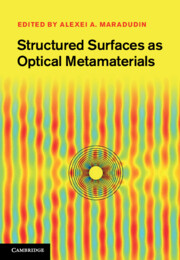Book contents
- Frontmatter
- Contents
- List of contributors
- Preface
- 1 Physics of extraordinary transmission through subwavelength hole arrays
- 2 Resonant optical properties of nanoporous metal surfaces
- 3 Optical wave interaction with two-dimensional arrays of plasmonic nanoparticles
- 4 Chirality and anisotropy of planar metamaterials
- 5 Novel optical devices using negative refraction of light by periodically corrugated surfaces
- 6 Transformation of optical fields by structured surfaces
- 7 Surface electromagnetic waves on structured perfectly conducting surfaces
- 8 Negative refraction using plasmonic structures that are atomically flat
- 9 Anomalous transmission in waveguides with correlated disorder in surface profiles
- 10 Cloaking
- 11 Linear and nonlinear phenomena with resonating surface polariton waves and their applications
- Index
- Plate section
- References
2 - Resonant optical properties of nanoporous metal surfaces
Published online by Cambridge University Press: 01 June 2011
- Frontmatter
- Contents
- List of contributors
- Preface
- 1 Physics of extraordinary transmission through subwavelength hole arrays
- 2 Resonant optical properties of nanoporous metal surfaces
- 3 Optical wave interaction with two-dimensional arrays of plasmonic nanoparticles
- 4 Chirality and anisotropy of planar metamaterials
- 5 Novel optical devices using negative refraction of light by periodically corrugated surfaces
- 6 Transformation of optical fields by structured surfaces
- 7 Surface electromagnetic waves on structured perfectly conducting surfaces
- 8 Negative refraction using plasmonic structures that are atomically flat
- 9 Anomalous transmission in waveguides with correlated disorder in surface profiles
- 10 Cloaking
- 11 Linear and nonlinear phenomena with resonating surface polariton waves and their applications
- Index
- Plate section
- References
Summary
Introduction
The structuring of a metal at nanoscale dimensions results in novel optical properties that are not present for bulk metals. Metallic photonic crystals, metal-based structures with periodicities on the scale of the wavelength of light, have attracted particular attention due to their unique optical properties. Among the approaches taken to prepare a three-dimensional photonic crystal is to take advantage of the self-assembly of spheres from a colloidal solution. Spherical colloidal particles of polymers or silica with diameters ranging from 20 nm up to 1 μm and larger, with low coefficients of variation in their diameter, are readily available. The methods of producing monodispersive colloids are well discussed in ref. [1]. The importance and interest of these particles lies in the fact that it is possible to induce them into a close-packed structure analogous to an ordinary close-packed crystal. There are several methods for self-assembly of colloidal spheres, in particular, sedimentation, evaporation, and electrophoresis. These close-packed arrays of uniform particles offer an attractive and, in principle, simple means to template the three-dimensional structure of a variety of materials.
Generally, self-assembly is restricted to the formation of close-packed two-dimensional or three-dimensional assemblies of colloidal particles. However, the low cost and availability of a relatively easy protocol to obtain this type of photonic crystals, artificial opals, make the self-assembly technique very attractive and widely used. The next step in the development of this technique to prepare metallic photonic crystal is to infiltrate the sample with some appropriate material, removing the original structure, and obtaining in this way inverted opals.
- Type
- Chapter
- Information
- Structured Surfaces as Optical Metamaterials , pp. 28 - 57Publisher: Cambridge University PressPrint publication year: 2011



